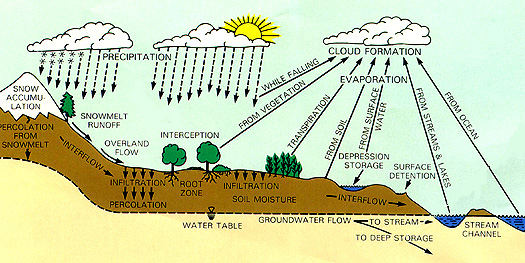Earth System Cycles¶
Contents
As stated earlier, many of the Earth�s natural systems tend to operate as cycles. The Water Cycle is of prime importance. At the heart of ESS is the Bretherton cycle. It is briefly explained on this page. Examples of biochemical and carbon cycles further emphasize how various factors and components interact.
Earth System Cycles
Next, we show several schematic or flow diagrams that give some indication of the intricately convolved components and areas (topics) of import to any of the systems - singly or combined - as they persistently modify the processes acting within them. First to look at is the vital Water Cycle.
This deceptively simple diagram is similar to those found in nearly all textbooks on environmental science, physical geology, and meteorology. It shows the pattern of water leaving and returning to the Earth’s surface. The process is cyclic, in that, eventually, a water molecule leaving the ocean to enter the atmosphere ultimately returns to that source. The rates of movement and the quantities involved (often shown in more detailed diagrams) vary among the specific processes (and within a process this variation changes in place and time of year). But, in the long run, the cycle continues, such that the various amounts maintain an overall mass balance, neglecting losses to outer space and gains from meteorites.
We invite you to peruse this diagram to gain a feel for how these processes, driven by energy, climate, biogeochemistry, and human activities, interrelate.
` <>`__16-11: What are the main drivers or controllers of these processes? `ANSWER <Sect16_answers.html#16-11>`__
` <>`__16-12: Do you believe everything you see in the above diagram is correct (sufficient connections)? `ANSWER <Sect16_answers.html#16-12>`__
One of the key cycles is that of the migrating and locating of carbon. Other geochemical element-based cycles include oxygen, nitrogen, phosphorus, sulphur, and iron. The next diagram outlines the main constituents (carbon and its compounds), and where they reside at any time within the four spheres. We find carbon in the solid Earth mainly in limestones and in petroleum and gas deposits.
Information on the mass balances within the carbon cycle has been obtained with fair reliability. We depict here the exchange of carbon, in units of 1015 g C yr-1, among the major reservoirs.
Carbon dioxide is a critical component in this cycle, being free in the atmosphere, dissolved in the oceans, integral in plant cells, and locked into sediments (limestones).
` <>`__16-13 Checking the above diagram, what is the main “source” (returning CO:sub:`2` to the active environment) and the main “sink” (receiving and storing the CO:sub:`2`) in the carbon geochemical cycle in today’s world? `ANSWER <Sect16_answers.html#16-13>`__
Because of the importance of this cycle, we recommend you visit this Carbon cycle site which reviews the fundamentals that affect this cyclical process.
From the above, we sense that Earth System Science deals primarily with matters of climatology and atmospheric physics/chemistry, as influenced by essential interactions with the ocean reservoir, water partitioning on the land, biological intakes and effluents, and particles and gases released from volcanoes. Unlike Landsat and similar programs, the emphasis of Earth System Science and its supporting EOS programs has shifted from solid Earth and land use to the environment. If you wish to learn more about the major study fields in Earth System Science, check the Foreword and first seven chapters in the (EOS Science Strategy Report).
Accelerated global change is, by definition, a global problem. In addition, as we already noted with the example of the SO2 aerosol generated by Mount Pinatubo. What happens in any region of our planet may affect many other regions. How, then, do we address and keep checking on these global concerns?
As we shall see later in this Section, the entire field of Earth Systems Science is at the heart of a huge, multinational effort to use space platforms to monitor the Earth’s atmosphere, oceans, biosphere, and active geosystems on the land. As part of that complex program, NASA has inaugurated as series of low cost, quick development satellite-based missions that go under the name Earth System Science Pathfinder (ESSP). Beginning in 2000, one to two launches per year will be highly focused on a single problem. Each mission will be run by the organization that “wins” in the semi-annual Announcement of Opportunity. That organization (be it public or private) will be funded to design, manage, and interpret the mission program, with help from NASA. The first two missions selected are code-named VCL and GRACE. You can learn more about this program on its Home Page at ESSP.
Dr. Mitchell K. Hobish, Consultant (mkh@sciential.com)




